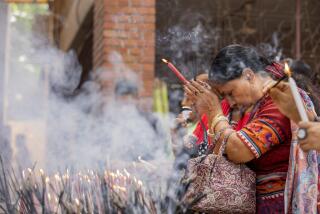Police Battle India Protest, Seize Thousands
- Share via
NEW DELHI — Riot police fired tear gas and water cannons, beat people with bamboo batons and rifle butts and arrested thousands of anti-government Hindu protesters who tried to rally here Thursday in defiance of a government ban.
The massive security crackdown, the largest ever seen in India’s capital, paralyzed the sprawling city but succeeded in preventing widespread violence by militant Hindu fundamentalists who have vowed to bring down the secular government of the world’s largest democracy and replace it with a right-wing Hindu state.
Many arrests were voluntary and peaceful.
But hundreds of people were pushed and kicked onto buses and driven to makeshift detention camps in three sports stadiums to join more than 20,000 people reported arrested here earlier this week.
Indian news services said that at least 60,000 people were pulled from trains, arrested in their homes and otherwise detained across the country in an attempt to block Hindus from attending the political rally.
Analysts said the heavy-handed tactics by tens of thousands of riot police and paramilitary troops who turned the heart of New Delhi into a virtual armed camp were likely to increase polarization in the country and opposition to the beleaguered minority government of Prime Minister P. V. Narasimha Rao.
“We’ve been saved from what could have been a fairly disastrous day,” said Dr. Rajni Kothari, a respected political analyst and human rights activist. “But there is no improvement.”
The rally was called by the right-wing Bharatiya Janata Party, India’s main opposition party. Once a political fringe group, the BJP has ridden a wave of Hindu nationalism and anti-Muslim militancy since the destruction by Hindu zealots of a disputed 16th-Century mosque in the north Indian town of Ayodhya on Dec. 6 during what was billed as a peaceful religious ceremony.
At least 1,940 people, the majority of them Muslims, died in fierce riots that subsequently swept the country, according to the government.
As an uneasy calm returned to New Delhi by late afternoon, BJP leaders complained at a news conference that police used unwarranted force to block a peaceful rally. They said 1,000 protesters were injured and 35,000 arrested.
A government spokesman said 88 people were injured and 4,691 arrested, including 110 members of Parliament.
Rajesh Pilot, the minister for internal security, said the crackdown was necessary given the explosion of Hindu-Muslim violence since December.
“The government has no choice but to maintain security,” he said. “The whole city was so tense today.”
All roads into New Delhi were heavily barricaded, and the city’s center was cordoned off as helmeted police on foot and horseback blocked all traffic with wire fences and roadblocks made of oil drums. Major streets were deserted; schools and shops were closed; offices were empty as residents stayed home.
The “Boat Club,” a popular esplanade near the Parliament where the rally was to be held, was blocked by several thousand police and thick rolls of razor-tipped concertina wire.
Police snipers were posted atop the government complex of looming, red sandstone buildings. Trucks with loudspeakers warned people against violating the rally ban.
Appearing on the steps of the Parliament an hour before the clashes began, opposition leader Lal Krishna Advani claimed victory because he said the government had panicked and shown how much officials fear the Hindu movement.
“We have already gained by the way they handled the rally,” he said. “The rally has been a success before it’s taken place.
“When the central government prevents the people of the country from entering the capital, it’s evident they’ve got a screw loose,” he said in Hindi. “This is the death knell for democracy in India.”
Advani and other top BJP leaders were later arrested. Murli Manohar Joshi, the party president, was hospitalized after he was sprayed by a water cannon and tear-gassed in a melee as he tried to lead about 300 activists toward the rally site.
Joshi fell or was knocked to the ground as he was hit by a sharp burst of water. The aging politician gasped for air as his supporters then flung themselves on top of him. Choking clouds of tear gas filled the street, and police used long bamboo canes and rifle butts to beat many in the crowd.
A hospital statement later said Joshi was in “stable but serious condition” with injuries to his head and thigh.
“The police are out of control,” complained J. V. S. Drona, a BJP member of Parliament. “We were trying to protect our party president. And they charged. We have not seen this even in the British time.”
Vasundhara Raje, a BJP member of Parliament who was caught up in the street battle, cried: “They’ve beaten women up! I got hit several times on the back.”
Many activists said they would seek arrest to demonstrate nonviolent opposition to the government. “After all these years, I must get arrested again,” said Viren Shah, a BJP leader who added he was last arrested in 1942 during the struggle against Britain for independence.
Clashes were reported at five sites where protesters had gathered. At a normally crowded intersection about two miles from Parliament, police chased thousands of slogan-chanting Hindus down side streets, firing tear-gas rounds and whacking at them with bamboo canes as they ran. Moments later, remnants of the crowd would reappear somewhere else, shouting taunts and waving paper flags, and the police would move in again. Many protesters were pushed, shoved and knocked to the ground as they were arrested. At least 16 buses were driven off with detainees.
Officials said those detained were likely to be released without charges within a day.
The BJP had threatened to marshal 1 million people into the streets, but the police crackdown kept the numbers far lower. The police used no gas masks and some appeared to suffer from the choking gas as much as the protesters did. Unseasonably cool weather, pewter gray skies and an occasional drizzle added to the day’s dour mood.
The BJP has demanded the prime minister’s resignation, the dissolving of Parliament and immediate elections, and the lifting of a ban on several extremist Hindu groups outlawed after the Ayodhya mosque was razed.
The party also demands that four BJP state governments dismissed after the Ayodhya debacle be reinstalled and that a Hindu temple be erected over the ruins of the destroyed mosque. Fundamentalist Hindus claim the Ayodhya mosque was built atop the birthplace of the Hindu deity Lord Rama.
Elections are not due until June, 1996. Recent polls have shown that the BJP, which now controls 119 seats in the Parliament, would gain support but probably not win the 260 seats necessary for a majority.
The prime minister was widely faulted for ignoring signs of trouble in Ayodhya and failing to prevent the violence there.
But a 122-page report issued Wednesday by Rao’s government accused the BJP leaders of “betrayal” and “conspiracy,” and put the whole blame on the BJP-led state government of Uttar Pradesh, where Ayodhya is located.
Thursday’s confrontation was a test of strength for both sides.
More to Read
Sign up for Essential California
The most important California stories and recommendations in your inbox every morning.
You may occasionally receive promotional content from the Los Angeles Times.














